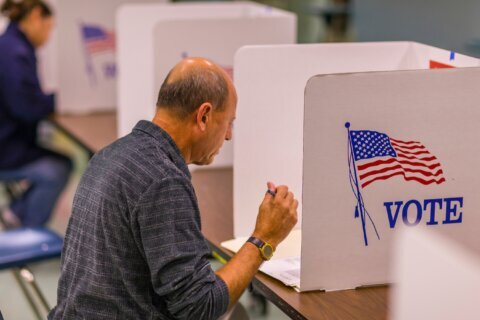Fairfax County’s School Health Advisory Committee is recommending that the Virginia school system set districtwide guidelines for technology use by grade level and set a cap for the amount of time the youngest learners spend on screens every day.
In its 2022-23 annual report to the school board, the committee said there shouldn’t be any one-to-one screen time for students before the fourth quarter of their kindergarten year. The report cites research from the American Academy of Pediatrics that says kids ages 2-5 should spend a maximum of one hour in front of a screen every day, including use in and outside of school. It’s also calling for Virginia’s largest school system to set screen limits by grade level.
This year, the committee focused on the impact of technology use on student wellness. The school system said it does have screen-time guidelines for decision making that teachers can use.
“I’m just seeing a very heavy dependency on the technology,” said Ricardy Anderson, a school board member. “If I see one more slide deck in my child’s work, I think I’m just going to lose it.”
In a presentation to the school board last month, the county’s SHAC members recommended better use of audio instead of defaulting to watching videos.
The lack of guidelines for tech use by grade level, SHAC co-chair Brenda Silvia-Torma said, “can lead to disparities in classroom screen-based work even for our youngest learners.”
“SHAC believes that FCPS should share the structure guidelines on maximum computer screen use by age level and that this would provide everyone with clear expectations and consistency across the county,” Silvia-Torma said.
Committee co-chair Ilana Yergin-Doniger said it can be challenging for parents, administrators and staff to know how much screen time students are getting, because it varies from classroom to classroom. So, the group is recommending a change in the process of how parents are informed about their students’ use of school-issued devices.
Currently, parents can opt in to receive a Lightspeed Parent Report, which includes a list of websites kids visited that week. The committee said the process should be opt out, because as of January, only about 5,000 parents were getting the reports.
“The reality is administrations at school oftentimes don’t know what’s going on at that level in the classroom, how much time students are spending on computers,” Yergin-Doniger said.
As part of its technology use recommendations, the committee said the school system should plan and promote a screen-free school day in the fall and a screen-free week toward the end of the school year.
“When we introduced the laptops during COVID, we made all these promises and told families not to worry, it’s going to be regulated,” board member Abrar Omeish said. “I don’t think our deployment lived up to that commitment. … I’ve been really surprised to see how many times I walk into a classroom and kids are doing something on a laptop.”
In addition to the technology recommendations, the committee also recommended later start times for middle schools along with earlier deadlines for homework — nine or 10 p.m. instead of midnight — two sleep-friendly decisions.
And in January, a SHAC student representative informed the committee that some high schools are locking some bathrooms during the day for the whole day.
“SHAC recognizes that there’s lots of serious safety, security issues regarding bathrooms, fentanyl overdoses, violence, sexual assault, vaping, vandalism, but preventing access to school bathrooms of course is unhealthy for all students and potentially embarrassing or even dangerous for those with certain medical conditions,” Silvia-Torma said.








